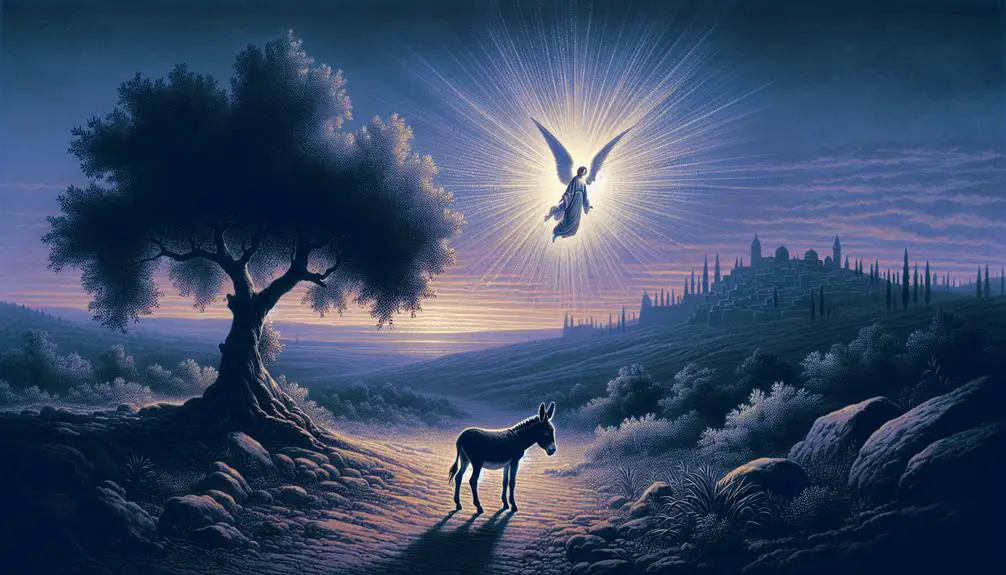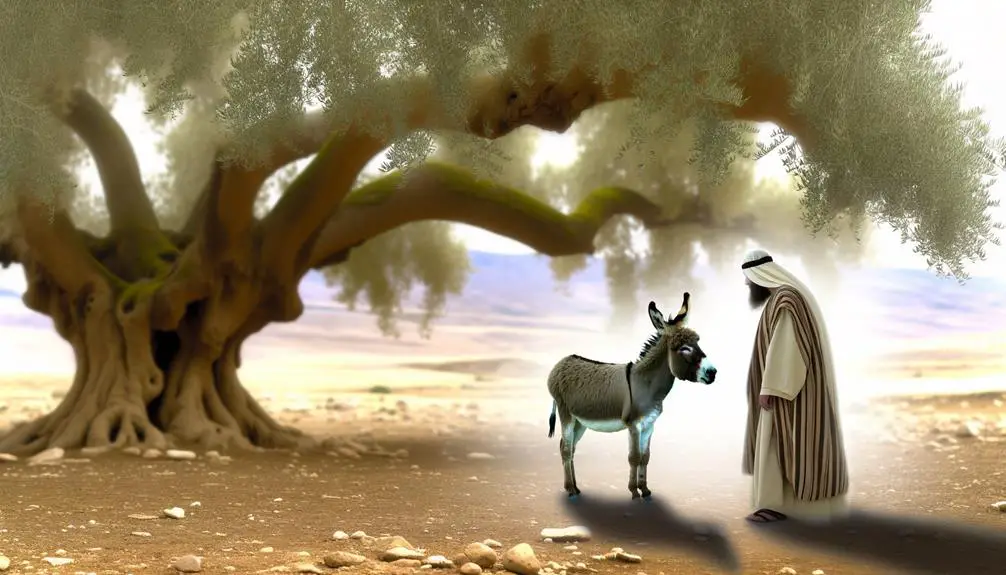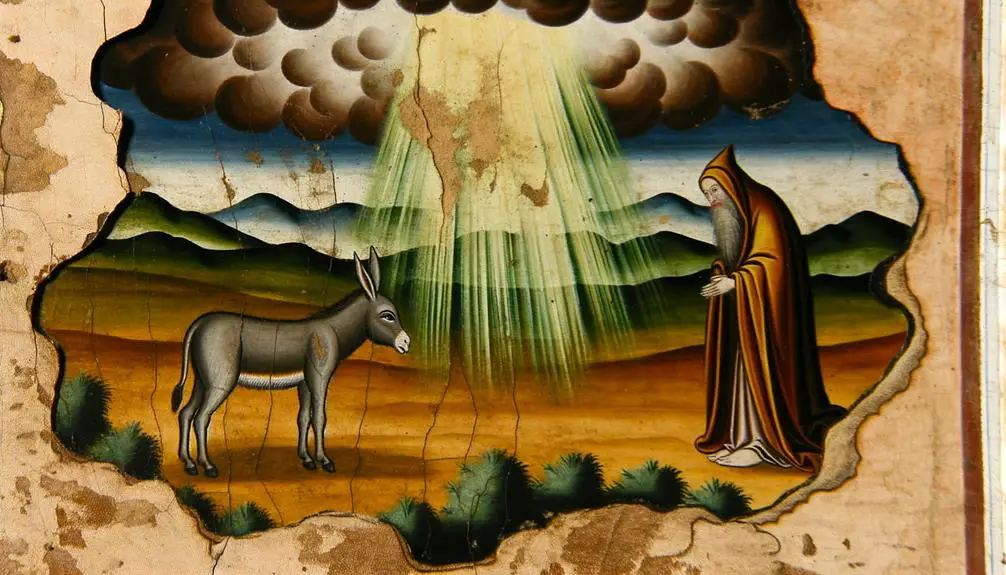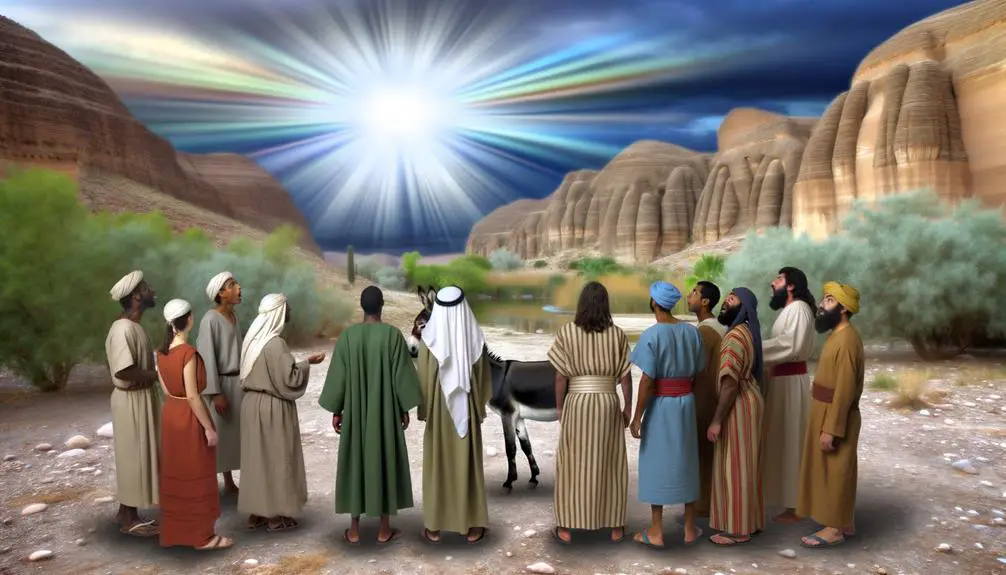Uncover the story of the talking donkey in the Bible, a narrative blending divine intervention with earthly astonishment.

What Animal Talked in the Bible
They say curiosity killed the cat, but in this case, it might just enlighten you.
You've likely heard tales of animals displaying remarkable intelligence or even seemingly communicating with humans, but there's one story that stands out above the rest, nestled within the pages of the Bible.
This tale involves an unexpected creature, one that not only spoke but held a conversation with a man.
The background and the implications of this biblical event have fascinated theologians and believers alike for centuries.
If you're intrigued by how this story bridges the realms of the divine and the earthly, and what it might suggest about communication and understanding beyond human capabilities, you're in the right place to uncover more.
Key Takeaways
- A donkey spoke to Balaam in the Book of Numbers, defying natural norms.
- The story symbolizes divine intervention and the potential for communication across creation.
- It challenges conventional views on animal intelligence and divine communication boundaries.
- This narrative enriches religious symbolism by illustrating unexpected methods of divine messages.
The Talking Animal Revealed

In exploring the realm of animals in the Bible, you encounter the intriguing instance of Balaam's donkey—a creature granted the ability to speak, revealing the profound interaction between the divine and the natural world. This narrative not only showcases an animal's unexpected capacity for speech but also opens a dialogue on animal intelligence and its representation in sacred texts.
The story of Balaam's donkey isn't merely an isolated tale of wonder; it's a window into the broader theme of divine intervention and communication through the natural world. You're invited to consider the implications of a world where animals, often considered lower beings, are vessels for divine messages. This narrative challenges traditional views on the hierarchy of creation, suggesting a closer, more interconnected relationship between all of God's creatures.
Furthermore, the talking donkey story bears mythological parallels, reminiscent of tales where animals bridge the human-divine gap. Similar stories in various cultures suggest a universal acknowledgment of animal intelligence and their potential role as messengers or intermediaries between realms. This cross-cultural motif enriches your understanding of the biblical narrative, highlighting its place within a larger tapestry of human belief in the extraordinary capabilities of animals.
In dissecting this narrative, you're not just delving into an ancient text; you're engaging with questions about the nature of intelligence, communication, and the divine's interaction with the world. These themes challenge you to reconsider your perspectives on the natural order and the potential for miraculous occurrences within it, fostering a deeper appreciation for the complexity and mystery of the world as depicted in biblical stories.
Background of the Biblical Story

Delving into the background of the biblical story, you'll find that the narrative of Balaam's donkey unfolds in the book of Numbers, offering a rich tapestry of moral and theological lessons. This story, deeply embedded in the historical context of the Israelites' journey to the Promised Land, serves not only as a miraculous account but also as a potent vehicle for divine communication and guidance.
The tale is situated within a broader narrative that highlights the tension between the Israelites and the neighboring nations as they traverse the wilderness. Balaam, a non-Israelite prophet, becomes a pivotal figure due to his interactions with God and the supernatural occurrence with his donkey. Here's what sets the background of this story apart:
- Animal symbolism: The donkey, an animal commonly associated with humility and service in biblical times, becomes a conduit for divine intervention. This choice of animal speaks volumes about the nature of God's communication and the reversal of expected power dynamics.
- Historical context: The story is set during a period of uncertainty and conflict, reflecting the challenges faced by the Israelites. It underscores the theme of divine providence and protection over God's chosen people.
- Moral and theological implications: Beyond the surface-level narrative, the story of Balaam's donkey invites readers to ponder deeper questions of obedience, prophecy, and the nature of divine revelation.
The Conversation Between Man and Beast

One of the most striking aspects of the story of Balaam's donkey is the direct communication between the prophet and his animal, a moment that defies our usual understanding of the natural world. This narrative highlights a profound consideration of animal intelligence, suggesting that the creatures we share our world with have the capacity for understanding and even reasoning that we rarely acknowledge.
The dialogue between Balaam and his donkey goes beyond mere novelty or supernatural occurrence; it serves as a potent reminder of the interconnectedness of creation. It challenges you to reconsider the boundaries of communication and intelligence, traditionally reserved for human beings, and to acknowledge the possibility of wisdom residing in what we might've dismissed as mere beasts.
Furthermore, this episode is rich in mythological symbolism, echoing ancient traditions where animals act as mediators between the divine and the human realms. This isn't just a tale of a talking animal but a theological statement about the ways in which God can choose to reveal Himself and His plans. The donkey, often seen as a humble and lowly creature, becomes a vessel for divine intervention, subverting human expectations and highlighting a theme recurrent in biblical texts: that strength and wisdom often come from unexpected places.
In examining this interaction, you're invited to explore the deeper layers of meaning behind what might initially appear as a simple anomaly. This story encourages a reflection on the nature of communication, the value of humility, and the broader implications of recognizing intelligence and agency in all of God's creation.
Interpretations and Meanings

Exploring the story of Balaam's donkey, you'll find that its layers of meaning extend beyond a mere curiosity, offering insights into divine communication and the unexpected vessels of God's wisdom. This narrative isn't just an ancient tale; it's a profound exploration of the ways God chooses to reveal His will, often through means we mightn't anticipate or immediately understand.
The incident with Balaam and his donkey opens up a rich field of theological debates and interpretations, revolving around several key aspects:
- Animal Symbolism: The donkey, often seen as a humble and overlooked creature, is suddenly placed at the center of a divine message. This choice by God to use a donkey as His messenger might suggest a broader theme of valuing all of creation and recognizing potential in the most unlikely places.
- Divine Communication: The story underscores the belief that God can use any means He deems suitable to communicate with humans. Whether through dreams, visions, or even animals, the methods of divine revelation are boundless and often surprising.
- Theological Debates: This event has sparked discussions among scholars and believers about the nature of prophecy, the will of God, and the interaction between the divine and the mundane. The talking donkey becomes a focal point for debating the limits of human understanding and the ways in which God's messages are delivered and interpreted.
The narrative of Balaam's donkey challenges you to reconsider preconceived notions about divine communication, urging a deeper reflection on the myriad ways God speaks to His creation.
Reactions and Impact on Believers

Through the narrative of Balaam's donkey, believers are prompted to reflect on the unexpected ways God may choose to communicate His wisdom and guidance. This story, rich in religious symbolism, challenges the conventional boundaries of divine communication, encouraging followers to remain open to God's messages, regardless of the medium. The inclusion of an animal as a vessel for God's voice not only adds a layer of intrigue but also deepens the faith of believers by reinforcing the idea that God's ways are beyond human comprehension.
The reaction among believers to this tale often involves a blend of amazement and introspection. It serves as a reminder that faith requires humility and the acknowledgment that divine wisdom can permeate through all of creation, including animals. This perspective helps to mitigate animal skepticism, a common reaction where the credibility of an animal's role in conveying divine messages might be questioned. Instead, the story encourages an appreciation for the complexity and inclusivity of God's world, where every creature has a purpose and potential as a messenger of divine truth.
Furthermore, the narrative encourages believers to consider the broader implications of religious symbolism in their faith. It invites a deeper exploration into the ways symbols and allegories are used throughout the Bible to convey spiritual truths. By engaging with these symbolic elements, believers can enhance their understanding and appreciation of biblical teachings, leading to a more profound and enriched spiritual life.
Modern Perspectives on the Tale

How do contemporary believers reconcile the tale of Balaam's donkey with modern understandings of faith and divine communication? This question invites a nuanced exploration of the intersection between ancient narratives and current theological perspectives. In the context of Balaam's story, the speaking donkey isn't merely an anomaly but serves as a profound example of divine intervention and the broad capacities for communication that transcend human understanding.
In analyzing this tale through a contemporary lens, several key considerations emerge:
- Animal linguistics: Modern believers often interpret the story as emblematic of the broader theme that God's creation, including animals, possesses intrinsic value and potential for divine interaction. This perspective aligns with current interests in animal cognition and communication, suggesting that the tale of Balaam's donkey might reflect a deeper, symbolic truth about the capacity for understanding between species, orchestrated by a divine creator.
- Mythological parallels: Scholars and believers alike note the presence of similar stories across various cultures where animals bridge the human-divine communication gap. This recognition of mythological parallels doesn't diminish the tale's value but rather enriches its significance by situating it within a broader narrative tradition that underscores the universality of divine messages conveyed through creation.
- Faith-based interpretation: Finally, many contemporary believers view the story as a reminder of the unexpected ways in which God can communicate and assert divine will. It challenges adherents to remain open to the myriad forms through which divine guidance can manifest, often beyond the bounds of human expectation.
Through these lenses, the tale of Balaam's donkey continues to inspire and provoke thought among modern believers, bridging ancient wisdom with contemporary spiritual inquiry.
Frequently Asked Questions
How Have Depictions of the Talking Animal in the Bible Influenced Art and Literature Outside of Religious Texts?
You've seen how artists and writers have woven the image of a talking animal into their works, beyond religious scripts.
This motif has inspired cinematic adaptations, breathing life into modern parables that resonate with contemporary audiences. These adaptations often explore themes of wisdom, morality, and the miraculous, encouraging a deeper reflection on the human condition.
This interplay between ancient text and modern creativity highlights the enduring influence of biblical narratives in artistic expression.
Are There Similar Stories of Animals Speaking in Other Religious or Mythological Traditions, and How Do They Compare to the Biblical Account?
Peering into the tapestry of myths, you'll find threads of talking animals woven throughout various cultures, akin to finding hidden treasures. These mythological parallels cast light on how different societies envision animals bridging the human-divine communication gap.
Analyzing these stories showcases the cultural impacts of such narratives, providing insights into the collective psyche. They echo the biblical account, yet each bears its unique flavor, reflecting the diverse spiritual landscapes from which they spring.
What Role Do Animals Play in Biblical Narratives Beyond This Specific Talking Animal Story, and How Does It Reflect on Humanity's Relationship With Nature According to the Bible?
In the Bible, animals play roles that highlight divine intervention and humanity's duty towards ecological stewardship. You'll find that beyond talking animals, these narratives often serve as a mirror, reflecting how humans should interact with nature.
This relationship isn't just about dominion but also about care and respect. It's a call to recognize the sacredness in all of God's creation and to act as responsible stewards of the earth.
How Have Scientific Advancements and Studies in Animal Communication Challenged or Supported the Notion of Animals Speaking as Described in the Bible?
Scientific advancements in animal linguistics have opened a Pandora's box, challenging our understanding of communication. Studies show animals communicate complexly, albeit differently from humans, supporting the notion that they possess their own forms of language.
This aligns with biblical narratives in a metaphorical sense, suggesting a divine spark within all creatures. Communication theories further bridge the gap, inviting a deeper, faith-based analysis of our interconnectedness with nature's chorus.
In What Ways Have Contemporary Interpretations of This Biblical Story Been Utilized in Discussions About Animal Rights and Ethical Treatment of Animals?
You're navigating how contemporary interpretations spotlight animal rights, leaning on animal linguistics and ethical veganism. Scholars and activists argue that understanding animal communication challenges us to rethink our ethical obligations towards them.
This perspective, rooted in faith-based respect for all of God's creation, supports a shift towards ethical veganism by highlighting the moral imperative to treat animals with compassion. This mirrors the respect and awe inspired by their abilities to communicate, as depicted in sacred texts.
Conclusion
In your journey through the sacred texts, you've encountered the extraordinary narrative of the talking serpent in the Garden of Eden. This tale, more than mere folklore, symbolizes profound truths about temptation and communication between the divine and humanity.
Its echoes throughout history have shaped believers' understandings, nudging them towards a deeper contemplation of the spoken word's power.
As we reflect on this celestial dialogue, let it inspire a richer, more nuanced faith, blending scholarly insight with spiritual enlightenment.



Sign up